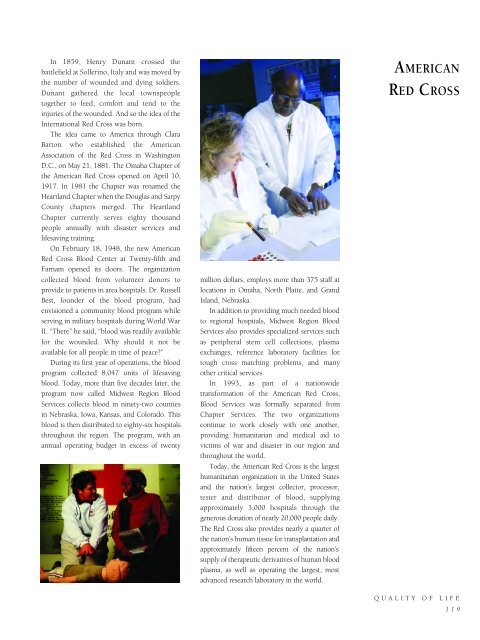Historic Omaha
An illustrated history of Omaha and the Douglas County area, paired with the histories of companies, families and organizations that make the region great.
An illustrated history of Omaha and the Douglas County area, paired with the histories of companies, families and organizations that make the region great.
Create successful ePaper yourself
Turn your PDF publications into a flip-book with our unique Google optimized e-Paper software.
In 1859, Henry Dunant crossed the<br />
battlefield at Solferino, Italy and was moved by<br />
the number of wounded and dying soldiers.<br />
Dunant gathered the local townspeople<br />
together to feed, comfort and tend to the<br />
injuries of the wounded. And so the idea of the<br />
International Red Cross was born.<br />
The idea came to America through Clara<br />
Barton who established the American<br />
Association of the Red Cross in Washington<br />
D.C., on May 21, 1881. The <strong>Omaha</strong> Chapter of<br />
the American Red Cross opened on April 10,<br />
1917. In 1981 the Chapter was renamed the<br />
Heartland Chapter when the Douglas and Sarpy<br />
County chapters merged. The Heartland<br />
Chapter currently serves eighty thousand<br />
people annually with disaster services and<br />
lifesaving training.<br />
On February 18, 1948, the new American<br />
Red Cross Blood Center at Twenty-fifth and<br />
Farnam opened its doors. The organization<br />
collected blood from volunteer donors to<br />
provide to patients in area hospitals. Dr. Russell<br />
Best, founder of the blood program, had<br />
envisioned a community blood program while<br />
serving in military hospitals during World War<br />
II. “There” he said, “blood was readily available<br />
for the wounded. Why should it not be<br />
available for all people in time of peace?”<br />
During its first year of operations, the blood<br />
program collected 8,047 units of lifesaving<br />
blood. Today, more than five decades later, the<br />
program now called Midwest Region Blood<br />
Services collects blood in ninety-two counties<br />
in Nebraska, Iowa, Kansas, and Colorado. This<br />
blood is then distributed to eighty-six hospitals<br />
throughout the region. The program, with an<br />
annual operating budget in excess of twenty<br />
million dollars, employs more than 375 staff at<br />
locations in <strong>Omaha</strong>, North Platte, and Grand<br />
Island, Nebraska.<br />
In addition to providing much needed blood<br />
to regional hospitals, Midwest Region Blood<br />
Services also provides specialized services such<br />
as peripheral stem cell collections, plasma<br />
exchanges, reference laboratory facilities for<br />
tough cross matching problems, and many<br />
other critical services.<br />
In 1993, as part of a nationwide<br />
transformation of the American Red Cross,<br />
Blood Services was formally separated from<br />
Chapter Services. The two organizations<br />
continue to work closely with one another,<br />
providing humanitarian and medical aid to<br />
victims of war and disaster in our region and<br />
throughout the world.<br />
Today, the American Red Cross is the largest<br />
humanitarian organization in the United States<br />
and the nation’s largest collector, processor,<br />
tester and distributor of blood, supplying<br />
approximately 3,000 hospitals through the<br />
generous donation of nearly 20,000 people daily.<br />
The Red Cross also provides nearly a quarter of<br />
the nation’s human tissue for transplantation and<br />
approximately fifteen percent of the nation’s<br />
supply of therapeutic derivatives of human blood<br />
plasma, as well as operating the largest, most<br />
advanced research laboratory in the world.<br />
AMERICAN<br />
RED CROSS<br />
QUALITY OF LIFE<br />
119
















